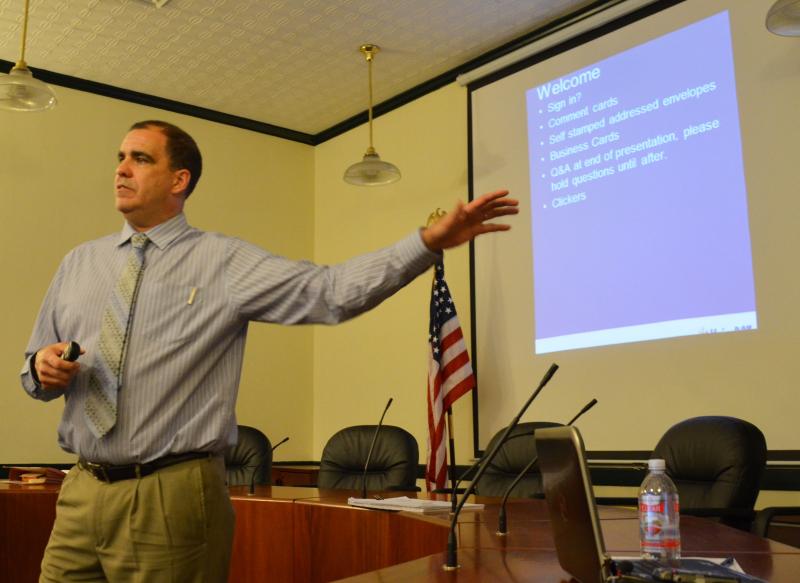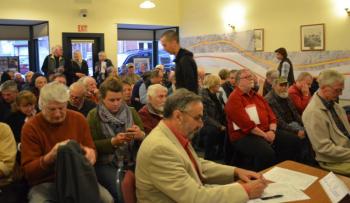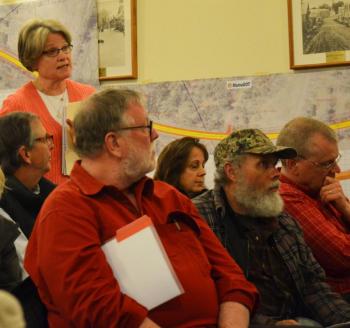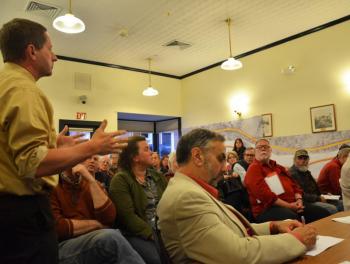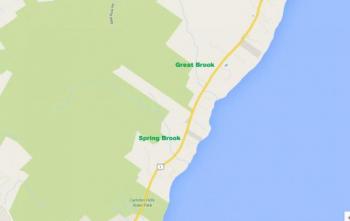Camden, Lincolnville give DOT manager an earful about Route 1 rebuild proposal
CAMDEN — “Oh my God,” gasped a woman from the back of the Camden meeting room, when Maine transportation official Ernie Martin said the proposed rebuild of Route 1 north of the Camden Hills State Park to the Lincolnville town line might resemble that of the recent highway reconstruction in Warren.
Not the 2002 rebuild, Martin was quick to add. He was referencing the 2014-2015 Route 1 Warren project.
“Go to the newest one, near the prison,” he said.
That was a loaded distinction, and one not lost on the 50 or so citizens, town officials and state representatives who had gathered May 4 in Camden in the Washington Street Meeting Room. Martin, who is a project manager with the Maine Department of Transportation, was there to describe how the proposed reconstruction of 1.54 miles of Route 1 from the park entrance to the town line is to be engineered. The road reconstruction project is scheduled for 2017, and expected to last 18 months.
Martin told the crowd that plans remained preliminary, and that he would return in July or August, with a final road design.
“We are not talking about right of way tonight,” he said. “We are just getting you guys informed about what is proposed.”
What is proposed leaves residents with varying levels of concern. Some like the idea of an improved roadway and wider shoulders, but they hold few illusions that drivers will drive any slower on a road posted at 50-55 miles per hour.
Some are prepared to lose 14 or more trees in their front yards, and ask practical questions about the relocation of water tanks and culverts and leach fields.
Others are focused on the character of the historic Route 1 itself, and its aesthetic importance to the region that is dependent on tourism. They do not, they say, want a road that resembles Route 90.
And still others focus on public safety, and want a road that is lined by a pedestrian/bike path.
And Martin, representing the state’s highway department, wants to fix a road plagued with drainage issues, which spills over into public safety and maintenance problems.
He was firm in that the Route 1 would be widened, and that the travel lanes would each be 11 feet in width.
“They won’t go under 11 feet,” he said.
Martin also said the proposal did not include a bike/pedestrian path. The shoulders, whether four or five feet in width, would make it safer for biking, he said, and for law enforcement to stop traffic violators.
The Warren rebuild and ensuing protest in 2002 was considered by some as a DOT debacle, as protestors occupied the branches of trees that were ultimately downed. Maine state troopers were called in, and arrested those who had chained themselves to the Elephant Tree, the icon of the road widening opposition.
That clash between the state and citizens resulted in discussions about highway aesthetics, community character preservation, and better citizen involvement in road designs. Twelve years later, the DOT resumed the next section of the Route 1 rebuild in Warren, and the project went much more smoothly.
Martin traveled to Camden May 4 to talk more with citizens about the new project to reconstruct what is now simply referred to as “Route 1 North.” He was accompanied by DOT Assistant Director of Planner Scott Rollins, landscape engineer, a meeting facilitator, a meeting minute transcriber, and other support staff.
At one point in the meeting, he said, “I’m here tonight because you pushed the envelope.”
The rebuild of Route 1 North has been a topic since last January, when the Camden and Lincolnville select boards convened a special joint meeting to discuss project implications in their communities. The $4.6 million road project (price tag excluding the new bridges) includes digging down in the roadbed, raising the road over Spring Brook by seven feet, widening the shoulders, and clearing trees to let more sunlight onto the pavement.
The stretch is in bad shape, said Martin. Built in 1934, it has never been reconstructed to modern standards. Because of that, the Federal Highway Administration does not fund improvements to it.
“Water can’t get away from the road,” he said. “It hangs out in sub-base. What was done in 2014 was a skim coat, and just makes it look pretty.”
The highway there dips and curves, ices over in the winter, and vehicles often leave the road at Spring Brook Hill — or can’t even get up the hill — in snowstorms. At the Lincolnville town line, were 19 crashes occurred in 2013-2015, a spring abuts the road, causing it to easily ice over.
The highway has been a vital section of the 2,593-mile east coast highway since 1926, when the American Association of State Highway Officials agreed that Route 1 in Maine would begin at the U.S.-Canadian International Boundary at Fort Kent and thread south to Florida via Van Buren, Presque Isle, Houlton, Calais, Ellsworth, Bangor, Belfast, Rockland, Bath, Brunswick, Portland, Biddeford, Kittery to Portsmouth.
In 2006, the DOT rebuilt the 1.71-mile stretch of the Route 1 from Camden Village to the state park. The Route 1 North project is the next step before the highway rebuild continues into Lincolnville.
Road problems
Martin said at the May 4 meeting (available to watch here) that drainage is the primary issue, and managing how the water runs down the Camden Hills to Penobscot Bay is the engineering problem.
“The west side is upstream and we’re fighting a lot of drainage issues out there,” he said. “I call it a flash flood zone.”
Of those attending, 48 percent were Route 1 abutters, and 35 percent were Camden residents. This was known because 49 people in the audience were handed clickers before they sat down. The clickers were used in compiling opinions and information from the crowd — data that Martin could use when he returned to his office to review, or as he repeatedly said, “to digest,” the evening’s discussion.
On the wall was a long printout of project plans to date, complete to the identification of trees 12-inches in girth or more that are marked for removal.
According to the DOT, the anticipated saily number of vehicles driving that stretch in 2017 will be 7,680, traveling at an average of 50 miles per hour. By 2037, the DOT anticipates that traffic count to increase to 9,220 a day.
From 2013-2015, there were 21 crashes, 19 of them at the Lincolnville town line and two at the park entrance. Most of them were attributed to driver inattention.
The DOT fix
The project calls for “a lot of riprap to stabilize and slow the water down,” said Martin.
“There will be tree clearing,” he said, adding that trees will be marked with red dots.
The DOT said the existing right-of-way is mostly 66 feet in width, although the 33 feet from the center line of the road varies, especially near Spring Brook. There, the right-of-way is 170 feet, because Route 1 used to run more easterly than how it is presently built.
“If we built this 10 years ago, it would have been 100-foot-corridor right-of-way,” said Martin. “Today, it’s 80-foot corridor. Could it be less? Maybe. But I’m not going to commit any less on the easterly side. West is already at 40 feet.”
Martin emphasized: “I want to be clear that we are looking at an 80-foot zone.”
His goal is to slow the velocity at which the land is eroding down from the hills into the ocean, especially where Spring Brook and Great Brook run under the highway and toward the bay.
“It’s amazing how it is eroding just because of pure velocity coming out of that structure,” said Martin, referring to culverts.
Trees will be cleared from either side of the highway.
“When you start excavating you are going to get under the roots, and they won’t survive the impact,” said Martin.
Utility poles, 38-39 feet in height, will also be replaced, at a distance of 37 feet from the highway center line.
“Knowing the sensitivity of clearing, we are telling utilities to go with alley arm construction,” said Martin. Alley arms have one directional extension, as opposed to two arms at the top of the pole, he said, illustrating with slides (see photos at right). “That will save five feet of clearing.”
He added: “There’s going to a lot of clearing out there but I think we have minimized it from what it could have been.”
But he also said that every third pole will require a guy wire to connect from the back of the pole to the ground to secure the structure.
This is going to have some to have a guy to connect from back of pole to securing it.
Martin also clarified that if the town requested a speed study, the DOT would comply. However, speed limit studies rely on the 85th percentile on which to base speed limits. That means, the DOT analyzes at what speed the traffic moves at 85 percent of the time, with 15 percent driving above that.
That factors into the acceptable speed limit formula, as well as the geometric design of the road, the number of public and private driveways and roads, the number of roadside businesses, the total accidents in a three-year time frame and the number accidents of vehicles leaving driveways in a three-year period.
Then, the DOT conducts a series of test runs on that section of driving a certain speed.
“If a speed study is requested, the DOT has the responsibility to regulate, and it comes back at 60, guess what it is going to get posted at,” he said. “You’ve got to be carefuly for what you ask for.”
Martin said the final public hearing on the Route 1 North project would likely be in July and August 2016, with the job’s advertising to take place in 2017.
Citizen concerns
“Don’t think anything is not negotiable,” said Sen. Dave Miramant, D-Camden, turning to the room, which heated up with arms raised for questions.
Martin had posed a question to the audience, asking them to click their response. He asked, “Do you: Agree the project needs to be done? Disagree with proposed project?”
But several in the audience protested that the question was incorrectly structured.
“What about C?” asked one person.
“Forget this question,” said Martin. “Let’s skip it.”
He then asked, “was this presentation informative on proposed highway design?”
Of the 43 who responded, 77 percent said yes, 23 percent said no.
Camden resident Paul Cartwright, and who was a Select Board member in 2006 when the first section of Route 1 was rebuilt north the Camden Public Library, said: “We have a road that works pretty well the way it is. The DOT has a set way of doing this if they rebuild a road. Before, we lowered that speed limit.... I think there is a solution that we can build a section of the road and maintain rural character, with flexibility on the part of DOT and not adhering so strictly to criteria that may not adhere to our criteria.”
DOT Planner Scott...., who was on the job during the 2006 Camden Route 1 rebuild, said: “This needs reconstruction. We do very little reconstruction throughout the state in a year. This is one that really needs it.”
One abutter asked, “Is this project driven by the speed is 55 mph and drainage.”
“Drainage is 90 percent of what’s calling for the clearing,” said Martin.
Another person asked why that stretch of road lacked for maintenance over the years.
“Funding, resources, a comedy of errors,” said Martin. “Everyone is pinched for resources and manpower. There were five teams; now there are two, and me.”
Camden resident, arborist and co-owner of Tree Keepers Doug Johnson, asked what provisions existed for tree planting.
“We have a landscape architect,” said Martin.
“Will project shut the road down,” asked Miramant.
Martin said the road would be remain open, with one lane detour.
Route 1 abutter Heather Cashner asked for more examples of what the road would look like when completed, and asked about bike paths.
Martin suggested Route 1 in Warren, near the prison, as well as Windham River Road in Windham.
“There are no sidewalks or bike paths associated with this project,” he said. “If the town wishes to work with this in future terms talk to Scott [DOT planner].”
A five foot shoulder accommodates a rural area, he said.
“I wouldn’t want to bike out there,” said Martin.
“It appears that this is a done deal,” said Cashner.
“I’m getting a full course meal right now,” said Martin. “I am going to try to move forward on my own with some form of consensus. Am I going to please everyone in this room? Absolutely not. I am not going to please myself with everything I’m going to do.”
But, he said, the project is already approved “because it is in our work plan.”
Nancy Caudle-Johnson, also a Camden resident and co-owner of Tree Keepers, said the 2006 rebuild of Route 1 in Camden incorporated specifications from the town that the DOT needed to follow to protect different trees.
“In the process of cutting trees, heavy equipment will get behind that line,” she said. “Trees that have a critical root zone, they extend three times the root zone. All of the trees further in from the clear zone are going to be damaged, if their canopies are anywhere near where construction is done. It’s not going to be a corridor, it’s going to be a massive construction zone.”
Caudle-Johnson said that Maine is a state where people love to come to, and she was critical of the Route 1 work further south.
“I can’t stand to drive to Warren or Thomaston anymore because it makes me sick,” she said. “It was a beautiful rural highway. It’s going to affect business. People won’t stand to live along the road anymore. One thing after another, after another. We need our town to decide that they will speak for us and the DOT won’t move into to do this project before we have a signed a memorandum of understanding. Everyone has to get together and organize”
Martin said the two projects — Route 1 closer to Camden Village and Route 1 near the Lincolnville town line, are: “two different animals. High Street is pretty flat. We’re fighting a different animal. I’m digesting here. High Street is a different animal than what I have here.”
A bicyclist and Camden resident said he rides year-round from Camden to Northport. He said he loves trees, but the route needs improvement.
“I hope the town and DOT can move project forward so route can be made safe for multimodal users,” he said.
Jane Lafleur, who is director of the nonprofit Friends of Midcoast Maine, a regional smart growth organization, said she was concerned about change of character of the area.
“The wider and smoother we make this road the faster cars will go,” she said. “I think we should work to make speeds slower. We have one chance to get this right. We need to do it when it is ready to go and not rush it.”
Another Route 1 abutter said today’s drivers are a different generation and move fast along with road.
“We have a water issue that comes off of the hill,” she said. “We are going to lose a lot of trees and that grieves me.”
Another abutter said she would be losing 12 to 14 trees.
“When will you put in new trees,” she asked.
“Once we get to that point with consensus, Luther Yonce [Maine DOT property rights officer] will get right-of-way maps done, and part of that appraisal is trees,” said Martin. “I know the sensitivity here. Without a shadow of a doubt we will put something back. We won’t put back 24-inch oak.”
Camden Select Board member Leonard Lookner said the area: “is where the mountains meet the sea. How much passion did the DOT have for this very unique piece of road? How did it enter into your plan?
Martin replied the maintenance needs drove the project.
“The aesthetics have no plan at all,” said Lookner. “ You are just driving an 80-foot-wide highway through the most scenic area.”
Maine Representative Joan Welsh asked, “When you come back will there be adjustments?”
“I have a lot of digesting to do,” replied Martin. “I’ve got my work cut out.”
Camden resident Deb Dodge asked Martin to ask the initial question about project approval that arose earlier in the meeting.
He did, and 40 percent agreed with the project, and 60 percent disagreed.
“I’ve heard a lot of possible amendments tonight,” said Martin.
Chris Osgood, a member of the Lincolnville Route 1 Planning Committee, approved of the five-foot shoulders for bikes, and asked if the DOT would allow more time for the project to move forward.
It sounds like an awful lot but I can get answers,” said Martin.
Osgood referenced various documents, including the appendix of the Gateway Action Plan, from 2011, in which traffic calming measures, bike paths, and a scenic inventory are all discussed for Route 1 planning goals.
“This leads us to believe that there are all sorts of other options that can be brought to bear here,” said Osgood.
He said the Gateway Action Plan advocates for enhance downtown areas and maintain rural qualities in between. The 100-mile stretch of Route 1 through the Midcoast has been cited by the Federal Highway Administration in the Gateway One Corridor Plan of 2011.
“You guys may want to take a little extra time to bring some of this in,” said Osgood.
Others mentioned safety with out-of-staters renting homes and pulling out on highway.
“This is complex from an engineering perspective,” said Martin. “The pure analysis on this drainage is ridiculous, with the amount of water that comes from the hill. It’s huge.”
As for the temperature of the room, the citizen feedback, and the work cut out for him, Martin said: “I’m digesting and am pretty cool now.”
Camden resident Paul McDonald, who has worked for the DOT, said the agency “does not do this in a vacuum. This road is unbuilt, and there is only state money available to maintain it. If you build this section of the road you get 80-20 funding from federal money.”
“Can we make a corridor there that is safe for everybody?” he asked. The context sensitive solution has been done for a long time, they just put a name to it.”
Lafleur suggested a tree-to-tree site walk, as was done in 2006.
“Is that a possibility,” she asked.
“That is part of the digestion,” said Martin.
At the end of the meeting, he asked: “Is everybody all set with a five-foot corridor?”
Yes and no, was the response.
Maybe there is a takeaway, a shift that allows for a less than dramatic clear zone,” suggested Cartwright.
“This isn’t an easy piece of road,” said Martin.
I would suggest that the Select Board get together with interested people and put together a committee to have a group to work with the board,” said Dodge. “We need support of our town officials to have this happen the right way.”
By 8 p.m., the meeting ended, with Martin saying he would return to his office, listen to the transcription, and think.
Related stories
Camden readies for Route 1 north reconstruction and Route 1 south sidewalk
Camden, Lincolnville selectmen to talk about Route 1 rebuild plan
Design almost done for Route 1 rebuild north of Camden; Spring Brook Hill bridge to get raised seven feet
Editorial Director Lynda Clancy can be reached at lyndaclancy@penbaypilot.com; 706-6657.


